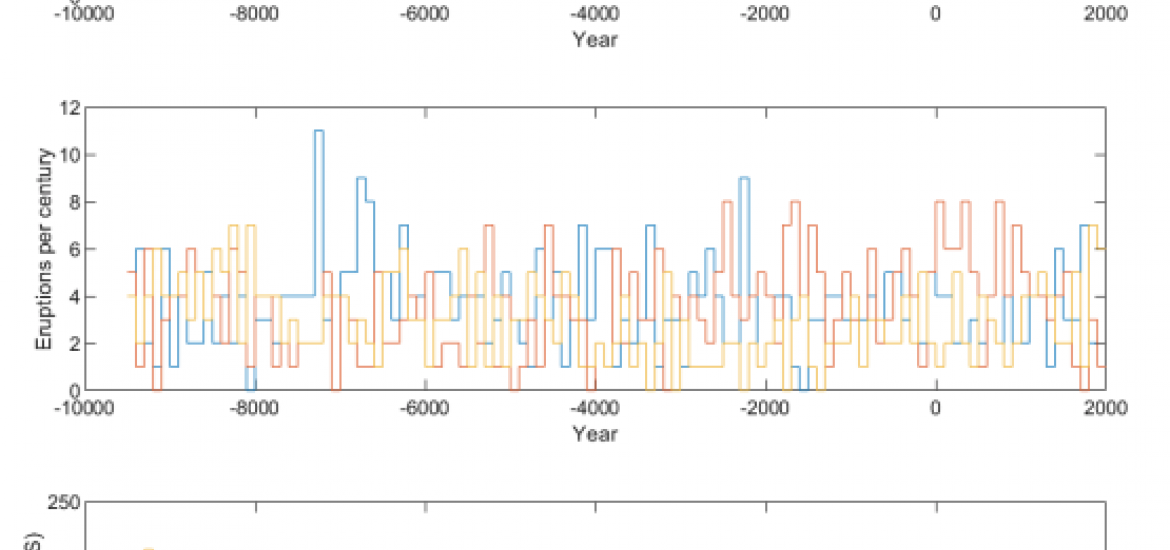- Home
- All News Overview
- VICS Working Group: Three New Papers

Monday, 4 July, 2022
The Volcanic Impacts on Climate and Society (VICS) working group has published two new papers, and one is currently in press (status: 4 July 2022).
Climatic, weather, and socio-economic conditions corresponding to the mid-17th-century eruption cluster
Authors: Stoffel M, Corona C, Ludlow F, Sigl M, Huhtamaa H, Garnier E, Helama S, Guillet S, Crampsie A, Kleemann K, Camenisch C, McConnell J and Gao C
In: Climate of the Past, 18, 1083–1108, 20 May 2022
DOI: https://doi.org/10.5194/cp-18-1083-2022
This paper investigates the sources of explosive volcanic eruptions in the 1630s and 1640s. It delves into their possible impact on contemporary climate using ice core, tree-ring, and historical evidence. It also assesses the socio-political context in which they occurred, and the human responses they may have triggered. The authors find that "this example shows that while the impacts of past volcanism must always be studied within the contemporary socio-economic contexts, it is also time to move past reductive framings and sometimes reactionary oppositional stances in which climate (and environment more broadly) either is or is not deemed an important contributor to major historical events."
The 852/3 CE Mount Churchill eruption: examining the potential climatic and societal impacts and the timing of the Medieval Climate Anomaly in the North Atlantic region
In: Climate of the Past, 18, 1475–1508, 29 Jun 2022
Authors: Mackay H, Plunkett G, Jensen BJL, Aubry TJ, Corona C, Kim WM, Toohey M, Sigl M, Stoffel M, Anchukaitis KJ, Raible C, Bolton MSM, Manning JG, Newfield TP, Di Cosmo N, Ludlow F, Kostick C, Yang Z, McClung LC, Amesbury M, Monteath A, Hughes2 PDM, Langdon PG, Charman D, Booth R, Davies KL, Blundell A and Swindles GT
DOI: https://doi.org/10.5194/cp-18-1475-2022
"The 852/3 CE eruption of Mount Churchill, Alaska, was one of the largest first-millennium volcanic events, with a magnitude of 6.7 (VEI 6) and a tephra volume of 39.4–61.9 km3 (95 % confidence). Here we assess the potential broader impact of this eruption using palaeoenvironmental reconstructions, historical records and climate model simulations. We also use the fortuitous timing of the 852/3 CE Churchill eruption and its extensively widespread tephra deposition of the White River Ash (east) (WRAe) to examine the climatic expression of the warm Medieval Climate Anomaly period (MCA; ca. 950–1250 CE) from precisely linked peatlands in the North Atlantic region."
Volcanic stratospheric sulfur injections and aerosol optical depth during the Holocene (past 11,500 years) from a bipolar ice core array
In: Earth System Science Data, In press
Authors: Sigl M, Toohey M, McConnell JR, Cole-Dai J and Severi M
DOI: https://doi.org/10.5194/essd-2021-422
Volcanism is a key driver of climate. Based on ice cores from Greenland and Antarctica, the authors reconstruct its climate impact potential over the Holocene. By aligning records on a well-dated chronology from Antarctica, we resolve long-standing inconsistencies in the dating of past volcanic eruptions. We reconstruct 850 eruptions which in total injected 7410 Tg of sulfur in the stratosphere and estimate how these changed the opacity of the atmosphere, a prerequisite for climate model simulations.
The VICS working group supports research focused on reconstructing the history of past explosive volcanism, in addition to research utilizing this knowledge to better understand how the climate system responds to changes in radiative forcing, and how societies have been impacted by and responded to the resulting climatic shocks.
> Find out more about the VICS working group here
> Join the VICS working group mailing list here